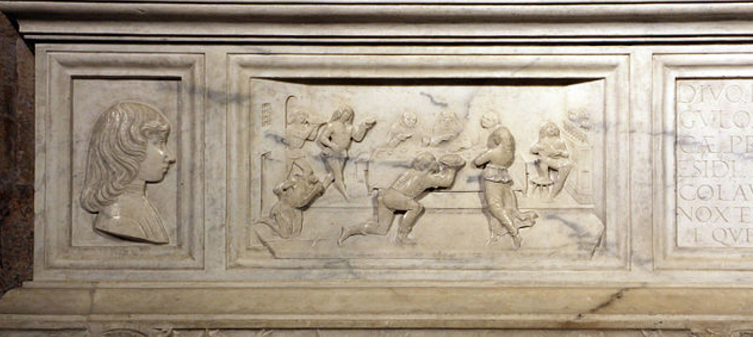
I present you with, not a treatise on art history in regards to the two artists, but an opportunity to compare two altars, both superb works of art, one located in the cathedral of Pisa, and the other in the cathedral of Lucca. The two altars are respectively, that of San Biagio by Stagio Stagi situated on the east wall of the left transept in the cathedral of Pisa, and that of San Regolo by Matteo Civitali also situated on the east wall of the left transept but in the cathedral of Lucca.
After undergoing various political/military vicissitudes, which in the 1400s severely tried the dwindling forces of the once glorious naval republic of Pisa, the Pisa cathedral was in need of a substantial refurbishing especially of it numerous antique altars plastered about haphazardly. In 1485, The task was assigned to the Lucchese architect and sculptor, Matteo Civitali. He was commissioned to produce twenty-two altars, but managed to complete one only and produce a few marble pieces (these can now be found reassembled in the cathedral museum). The reason the task assigned was not completed was probably due to the growing bitterness between Firenze (Florence) and Lucca, and the ultimate military fall of Pisa. Also Lucca was geographically surrounded.
Nonetheless, despite these tragic events, the taste for the classic, almost archaeological bequeathed by Civitali to a formation of sculptors working in Lucca, Pietrasanta, and Carrara had left its sign. In the 1520s it is with such an approach (antique but already with a Mannerist trace) that the Florentine Pandolfo Fancelli and Stagio Stagi of Pietrasanta produced the precursor to many such altars in the cathedral of Pisa: the altar of San Biagio, patron saint of the throat (I would therefore appoint him honorary patron of tourist guides).
In comparison to other altars of the same period, it is of relatively small dimension. It has an elaborate, but harmonious Renaissance geometric shape with grotesque decorations and elegant figures of impressive quality. The detailed and skilled intertwining of foliage with symbolic figures alluding to the passion of Christ and zoomorphic figures renders the white marble vibrant and allows the observer to lose himself within. But what is most striking are the outstretched arms of the two angels placed above the niche where San Biagio is found. They are of a neoclassical virtuosity, worthy precursors to a Canova sculpture. The arms are catalyst to this part of the monument. Their disproportionate extension towards the centre, in an almost flat bas relief, makes them appear to emerge delicately out of the milk-white marble.
Now moving over to Lucca, Matteo Civitali’s altar dedicated to San Regolo is of a commanding monumentality in comparison to the other altars present in the church. It was produced in the 1480s and according to critics, it launched the Lucchese artist to fame – a sculptor capable of elaborate and detailed monuments. With this altar, we have a vertical fusion of the learned knowledge of the classic architect with the skill of an unparalleled portraitist and narrator of stories.
The upper portion of the altar is similar to a sepulchral monument with the effigy of the Saint flanked by classic putti torch-holders. The lower portion of the altar has an altar step (predella) depicting the stories of the Saint summed up in a few panels. Its freshness of narrative and Renaissant modernity are quite incredible. Also noteworthy are the interior of the epochal palazzo in the banquet scene where the head of the Baptist is being served (you can almost hear the minstrel’s music), the dwarf (true protagonist with the dog at his feet – a precursor to the Florentine Morgante) who witnesses the martyrdom of Saint Sebastian and the executioner in the background, who, with his feathered hat and crossbow, recalls a young William Tell.
Two works of art, extremely diverse in composition and placed in diverse surroundings, nonetheless absolute protagonists of an era and of adjoining geographical areas.
Gabriele Calabrese